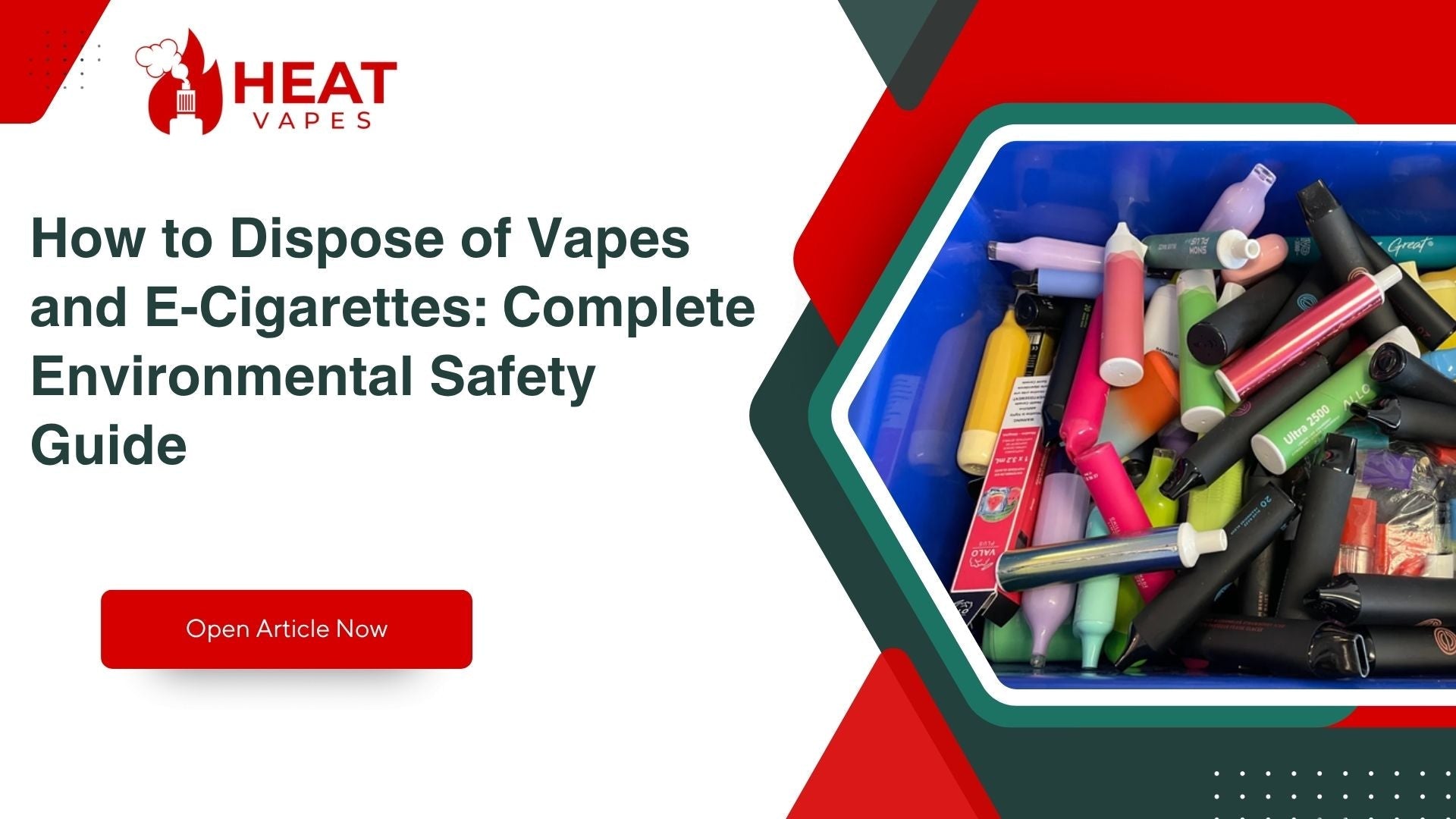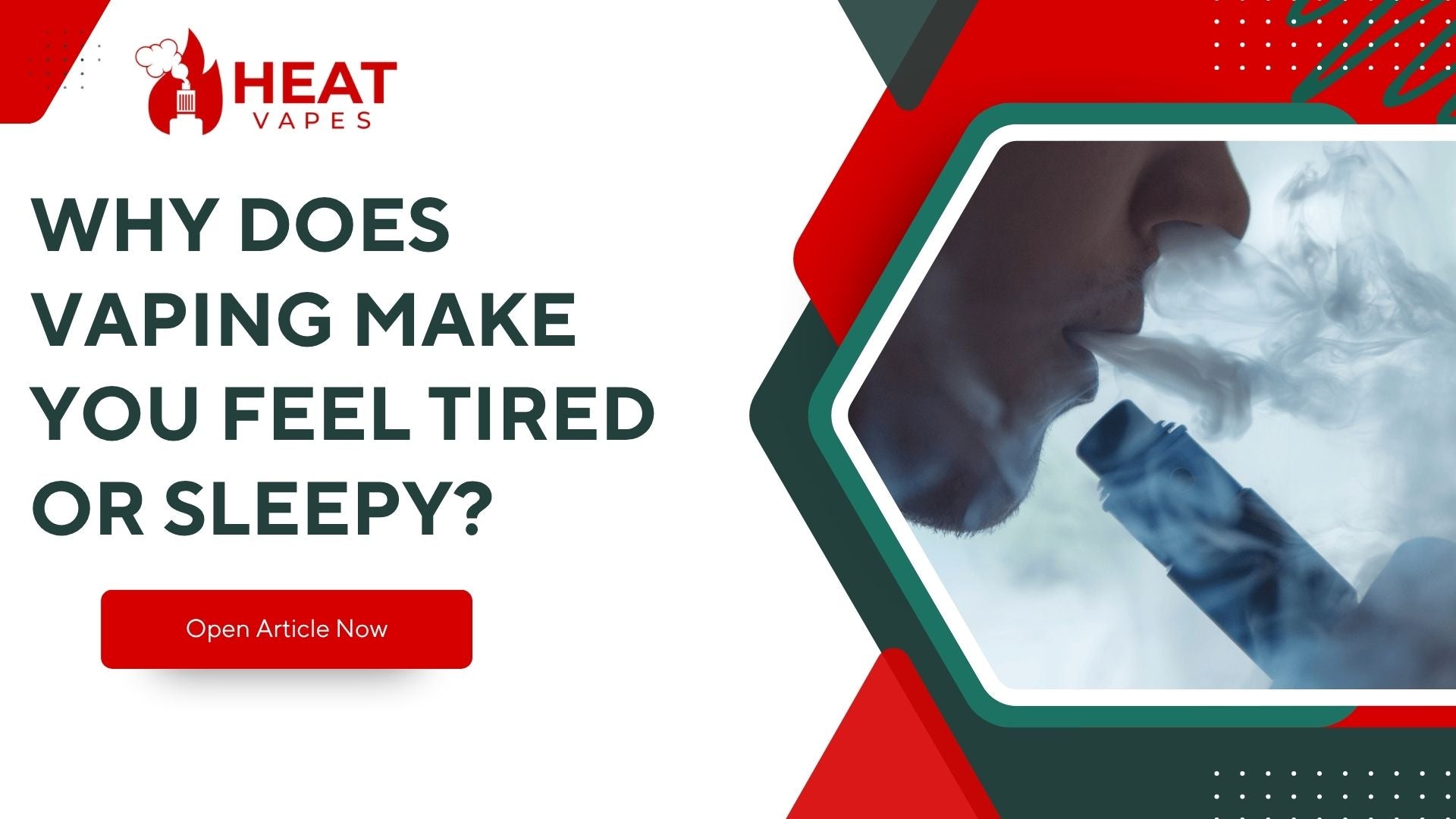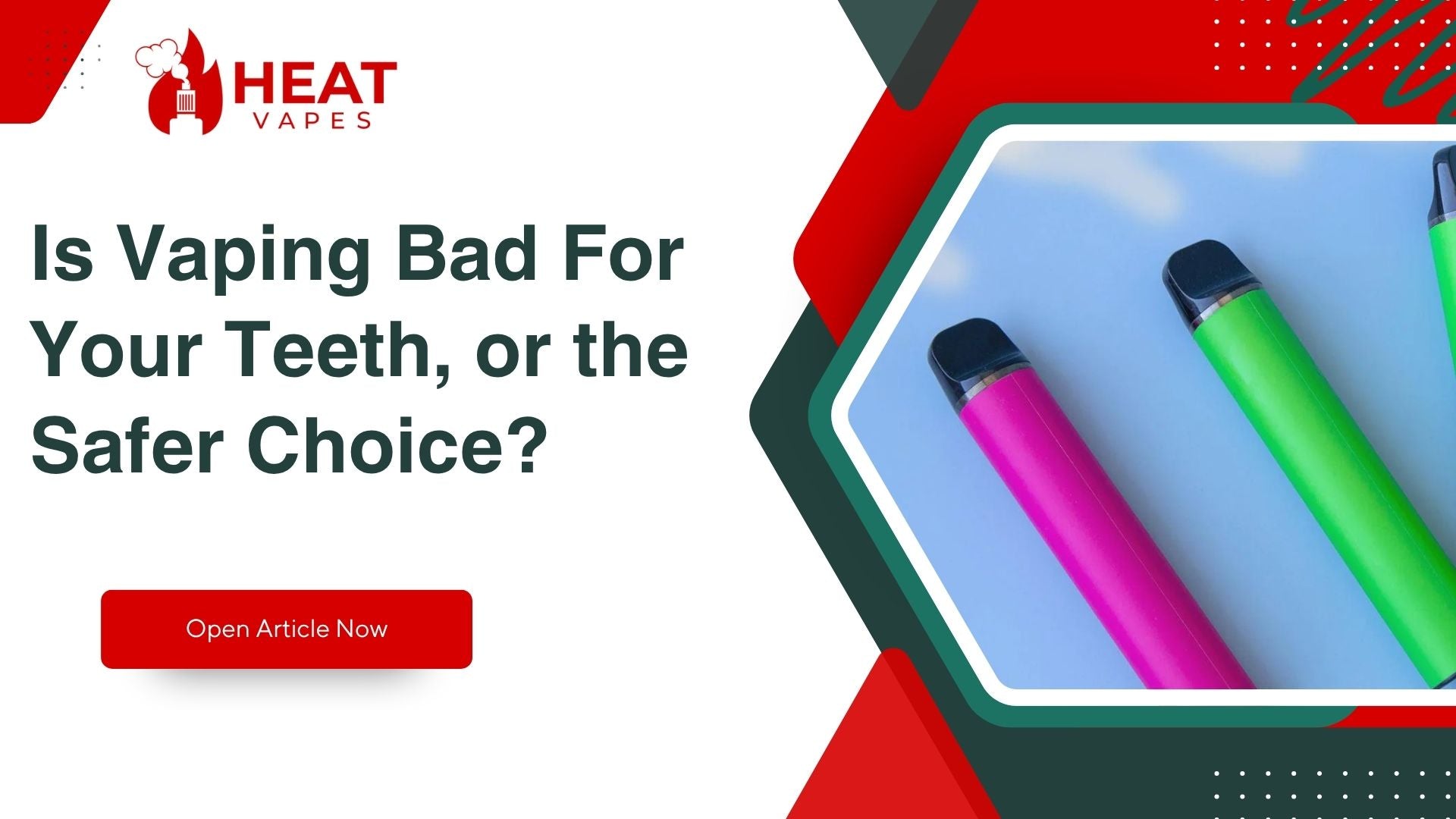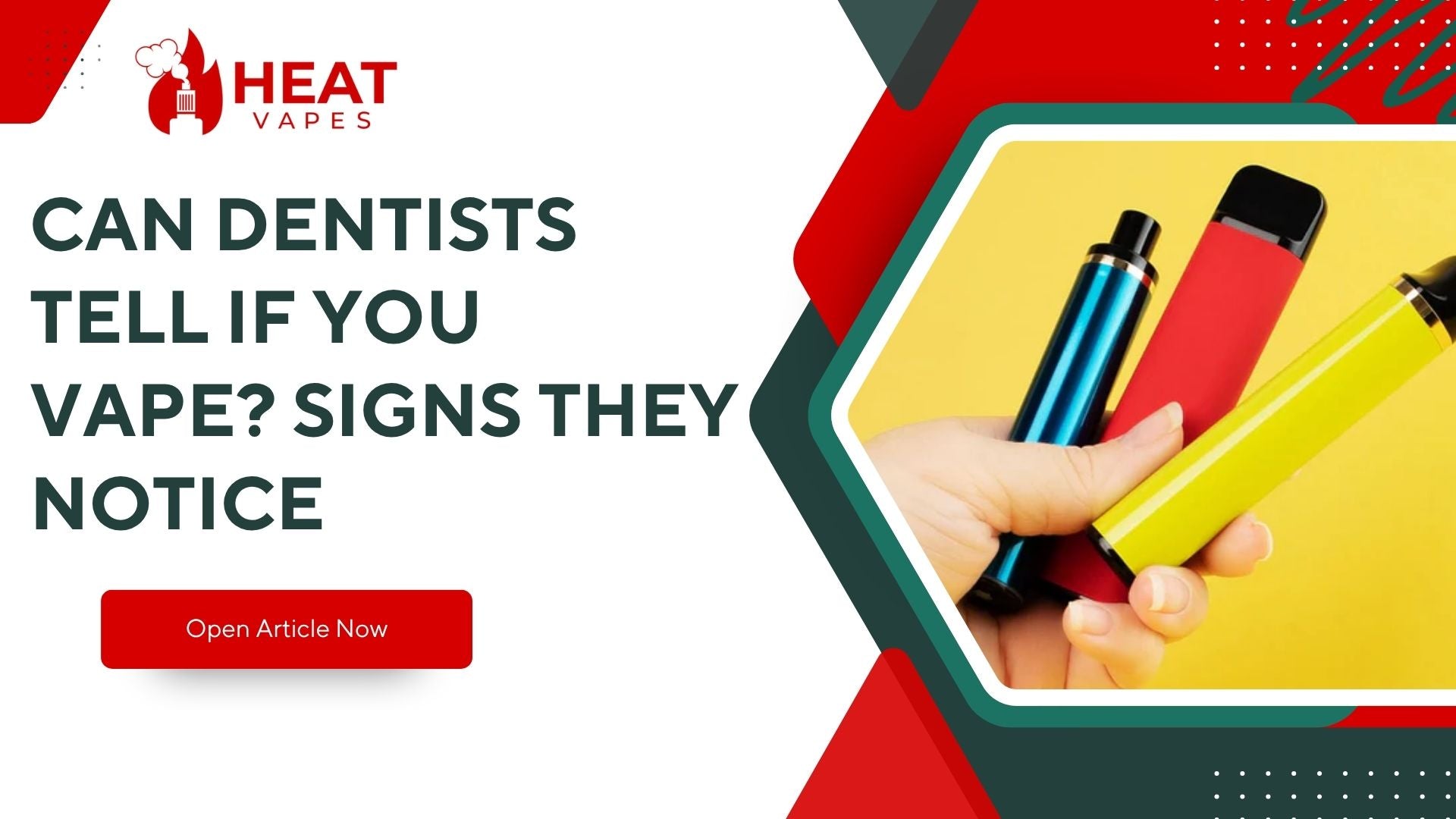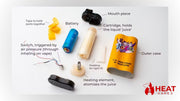
When it comes to vaping, it’s easy to get caught up in clouds, flavours, and sleek devices — but one question keeps popping up for many people: what exactly are we inhaling, and What Chemicals Are in Vapes? At Heat Vapes, we believe every vaper deserves to know what’s inside the liquids they’re using. And let’s be honest — if something’s going into your body, you should be informed.
In this guide, we break down every major component in e-liquids and the vapour they produce — no scare tactics, just clarity. Whether you’re a seasoned vaper, someone looking to switch from cigarettes, or just vape-curious, this is for you.
The Essentials: What Makes Up Vape Liquid
E-liquids, also called vape juices, are surprisingly simple in composition. Most of them share the same four core ingredients, each playing a specific role in your vaping experience.
1. Propylene Glycol (PG)
Think of propylene glycol as the invisible carrier of flavour in your vape. It's a thin, almost watery liquid that doesn't have much of a taste, but it does help those fruity or minty notes really come through.
PG also gives you that familiar tickle at the back of the throat so you wonder What Chemicals Are in Vapes? — similar to what you’d get from a cigarette.
-
Used for: Carrying flavour, creating a slight throat hit.
-
Common in: Medicines, asthma inhalers, food items.
-
Is it safe? In moderate amounts, PG is considered safe by regulatory agencies like the MHRA in the UK. Still, some folks find it a bit harsh and may experience dry mouth or throat irritation.
If you’ve ever taken a puff and felt that "bite," it’s probably PG doing its thing.
2. Vegetable Glycerin (VG)
If PG is all about the flavour and hit, vegetable glycerin is what makes those big, soft vapour clouds happen. It’s a much thicker, slightly sweet liquid that creates a smoother inhale.
-
Used for: Vapour production, smoothness, mild sweetness.
-
Found in: Toothpaste, cosmetics, and even some food products.
-
Is it safe? Yes, VG is widely accepted as safe. Most e-liquids balance it with PG to give you a blend of throat hit and vapour. But pure VG juices exist too, especially for cloud chasers.
VG is gentler on the throat, so if PG feels too sharp, a high-VG juice might be your fix.
3. Nicotine
Nicotine is the reason a lot of people start vaping — primarily when they are trying to quit smoking. It's a natural chemical from tobacco leaves that is highly addictive but not a cause of cancer.
-
Used for: Satisfying cravings, mimicking the effects of cigarettes.
-
Strengths: Ranges from 0mg (nicotine-free) up to 20mg (UK legal limit).
-
Forms: Freebase (more intense hit) or nic salts (smoother, quicker absorption).
Nicotine can affect your heart rate and blood pressure, but in vaping, you control the dose. Many people slowly reduce their intake over time — and some even go fully nicotine-free.
4. Flavourings
Here's where vaping becomes personal. Flavourings can turn a standard vape into a nostalgic dessert, a tropical holiday, or just a comforting menthol buzz.
-
Used for: Creating taste profiles like fruit, candy, tobacco, or bakery.
-
Sources: Usually food-grade, but vaping involves inhaling, not eating — so not all flavourings are equally safe when heated.
Some older flavourings, like diacetyl, have been linked to lung conditions and are now largely avoided by reputable brands. At Heat Vapes, we aim to work with partners who put safety and testing first, not just flavour intensity.
How to Dispose of Vapes in the UK: What You Must Know
What’s in the Vapour Itself?
When you inhale from your device, you’re not just breathing in the raw ingredients. You’re inhaling vapour created by heating the liquid, which can introduce a few additional chemicals — especially if your device runs too hot so you should know What Chemicals Are in Vapes?.
1. Acetaldehyde & Formaldehyde
These names might sound scary, and they do have a bad rap, but context matters. When e-liquid gets too hot (think burnt coil or dry hit), it can release trace amounts of aldehydes.
-
Common in: Cigarette smoke (in very high amounts), poorly maintained vape devices (in far smaller doses).
-
Risk: Elevated only when vaping at excessively high temperatures.
The fix? Stick to regulated mods, change your coils often, and don’t vape when the tank is dry.
2. Acrolein
Acrolein is another byproduct of overheating, mostly related to VG. It’s a known irritant and not something you want in your lungs regularly.
-
Risk level: Low if you’re using your device correctly.
-
Tip: Avoid burnt hits at all costs. If your vape tastes off — stop and check your coil.
3. Metals
Yes, small traces of metals like tin, lead, and nickel have been detected in some vapour studies. These usually come from the coil, not the liquid.
-
What causes it: Low-quality coils or excessive use of the same coil.
-
Prevention: Stick to trusted brands, and change your coils as recommended.
At Heat Vapes, we always recommend genuine hardware and advise against counterfeits that skimp on safety.
What You’re NOT Inhaling Compared to Cigarettes
Here’s the silver lining: vaping doesn’t involve combustion, which means you’re avoiding a laundry list of nasty substances found in cigarettes.
You're not inhaling:
-
Tar
-
Carbon monoxide
-
Arsenic
-
Ammonia
-
Cyanide
-
Thousands of additives are linked to cancer and lung disease
While vaping isn’t “healthy,” it’s widely recognised as a less harmful alternative to smoking, and has helped many make the switch for good.
The UK Regulations You Should Know About
Vaping in the UK is taken seriously in terms of public health. Under the Tobacco and Related Products Regulations (TRPR):
-
Nicotine strength is capped at 20mg/ml.
-
Bottles can’t exceed 10ml if they contain nicotine.
-
All products must be registered with the MHRA.
-
Ingredients must be clearly disclosed.
This ensures that what you’re buying is transparent and traceable, which is exactly what we stand for at Heat Vapes.
Tips for Choosing Better Vape Liquids
If you want to vape with confidence, here’s what we suggest:
-
Choose UK-compliant products only.
-
Buy from reputable brands and sellers.
-
Opt for liquids with full ingredient transparency.
-
Avoid products with overly strong chemical smells or poor packaging.
-
Store your e-liquids in a cool, dark place with lids firmly closed.
And if you're trying to step down your nicotine, do it slowly. There's no rush. Everyone's journey looks a little different.

Shocking Truth: What Chemicals Are in Vapes That Are Harmful
Vaping started off as the “healthier” alternative—the cleaner cousin to smoking. No tobacco, no ash, no thick cigarette stink. Just clouds of flavour and a smoother hit but still one must know What Chemicals Are in Vapes?.
But let’s not sugarcoat it—vaping still comes with its own baggage, and it’s important we talk about what’s really in those puffs.
At Heat Vapes, we don’t just sell vape gear—we care about what people are inhaling. We’ve seen too many people pick up vapes without understanding what they’re made of, and if we’re being honest, some of the chemicals in vapes are worth a second look.
So, let’s break it all down about What Chemicals Are in Vapes?—clearly, calmly, and with your health in mind.
What’s Actually in Your Vape Juice?
Most bottles of vape liquid are made from the same basic recipe:
-
Propylene Glycol (PG)
-
Vegetable Glycerin (VG)
-
Flavourings
-
Nicotine
Seems simple, right? PG gives you that throat hit, VG makes the clouds, flavourings make each puff feel like a treat, and nicotine? That’s what keeps you coming back for more.
But when you take all of that and heat it at high temperatures, your device can create byproducts that aren’t exactly your lungs’ best friends.
Nicotine: The Familiar Friend With a Dark Side
Let’s start with the obvious one: nicotine. If you've ever tried quitting smoking, you already know how addictive it is. But even in vapes, where the delivery is smoother and cleaner, nicotine still affects your heart, blood pressure, and brain.
What’s tricky is how easy it is to overdo it. With high-strength salts and compact devices that don’t feel harsh, it’s easy to puff all day without thinking. One minute you’re just taking a hit with your coffee, and before you know it, you’re reaching for it every 10 minutes.
Diacetyl: A Sweet Flavour With a Sour History
Ever heard of popcorn lung? It sounds ridiculous, but it’s real. Factory workers who inhaled butter-flavoured fumes in popcorn plants developed serious lung damage. The culprit? A chemical called diacetyl.
Some early vape liquids—especially dessert and buttery ones—used diacetyl for that creamy flavour. While many UK brands have moved away from it, you’ll still find it in shady imports or bargain-bin liquids with no ingredient info.
If a label doesn’t tell you what’s inside, steer clear.
The Ghost Chemicals: Formaldehyde and Acetaldehyde
Nobody’s pouring formaldehyde into vape juice. But when you crank up the voltage or vape dry coils, your e-liquid can heat to the point where it starts breaking down—and that’s when chemicals like formaldehyde and acetaldehyde can show up.
These aren’t just names you forget after high school chemistry. Formaldehyde is a known carcinogen. Acetaldehyde? Also linked to cancer. Neither belongs anywhere near your lungs.
So if you’ve ever had that burnt-coil taste and powered through it… just don’t. Toss the coil. Refill the tank. Your lungs deserve better.
Acrolein: The One You Can’t See Coming
You won’t taste it. You won’t smell it. But when vegetable glycerin gets too hot, it can create acrolein—an irritant that causes damage to your lungs over time.
What’s scary is that acrolein is also found in things like smoke and pollution. And while vaping doesn’t produce it in large amounts under normal use, chain-vaping at high heat can turn things ugly fast.

Metal Particles: Straight from Your Coil to Your Lungs
Here’s something a lot of folks don’t realise: your vape coil can slowly shed metal fragments into your vapour.
Studies have found traces of nickel, chromium, lead, and tin in vapour from poorly made coils. If that makes your stomach turn, it should. You wouldn’t grind up a teaspoon and breathe it in, right?
Stick to reputable brands and change your coil regularly. Old, degraded hardware is where problems sneak in.
Benzene: Hidden Danger in Some Flavours
Some flavour compounds—especially citrus and menthol—can turn into benzene when heated too much. What’s benzene? It’s a carcinogen found in petrol fumes and industrial smoke.
Now, we’re not saying every menthol puff is dangerous. But if you’re vaping at high wattages and pushing your liquid past its limit, you might be inhaling more than just minty coolness.
Fake Products: Where Things Really Get Risky
Let’s talk real-world stuff for a second. The biggest danger in vaping isn’t always the chemicals—it’s the lack of regulation in some products.
Black-market or counterfeit vape products can be a chemical wild card. You don’t know who made them. You don’t know what’s in them. And if they cut corners using cheap thinning agents or oils like Vitamin E acetate, you’re playing a dangerous game.
Stick with legit UK retailers. If something looks sketchy, smells weird, or doesn’t list ingredients—just don’t vape it.
So, Is Vaping Safer Than Smoking?
If we’re comparing apples to cigarettes, yes—vaping is less harmful. You’re not inhaling tar. You’re not burning paper and tobacco. You’re dodging a lot of what makes smoking deadly.
But let’s not call it “safe.” Especially when you’re:
-
Using a high-nicotine pod every day
-
Ignoring burnt coils
-
Buying mystery liquids from shady sites
Moderation matters. Quality matters. Awareness matters. You don’t need to give up vaping altogether, but you should know what’s in your juice and how your device works.
Where We Stand at Heat Vapes
At Heat Vapes, we don’t believe in cutting corners. We don’t manufacture our own liquids, but we take pride in only stocking products from brands we trust.
Our staff reviews every product we sell—so you're not simply purchasing something that's trendy; you're purchasing something that's safe, tested, and properly labeled.
We are headquartered in Manchester, and we deliver throughout the UK. As a new or seasoned vaper, our aim is to provide you with an easy, hassle-free experience—from shopping to checkout.
Ask Before You Inhale
We know how tempting it is to chase the biggest clouds or try every flavour under the sun. But your lungs aren’t replaceable. So if you’re going to vape, do it smart. Ask questions. Read labels. Carefully select your devices and liquids.
Because behind each sugary puff is a blend of chemicals, and not all of them are as nice as they appear. We'll always try our best to keep you posted and well-stocked with the good stuff. Because at the end of the day, your health does come first—yes, even in the vape world.
Conclusion: Know What You Inhale, Choose What You Trust
Understanding what chemicals are in vapes gives you control. It takes the mystery out of those clouds and replaces it with knowledge. PG, VG, nicotine, and flavourings — those are the basics. Beyond that, it’s about how you vape, what you use, and where you buy it from.
At Heat Vapes, we care about more than selling products. We care about building a community of informed, empowered vapers who know what they want — and what they don’t.
If you’re going to vape, do it with confidence. Do it smart. Do it with clarity.





